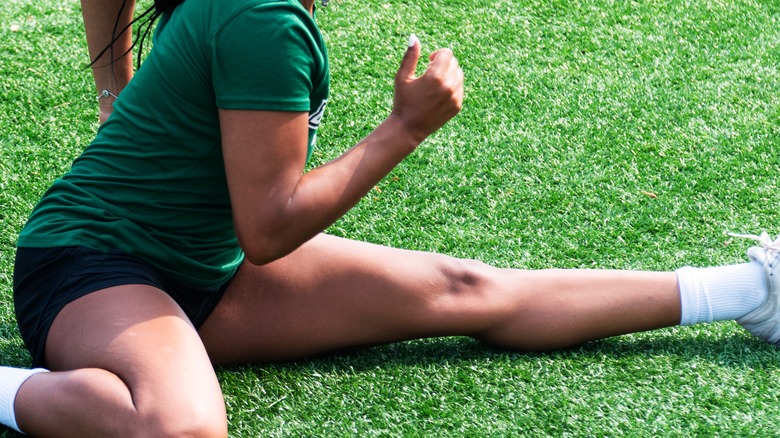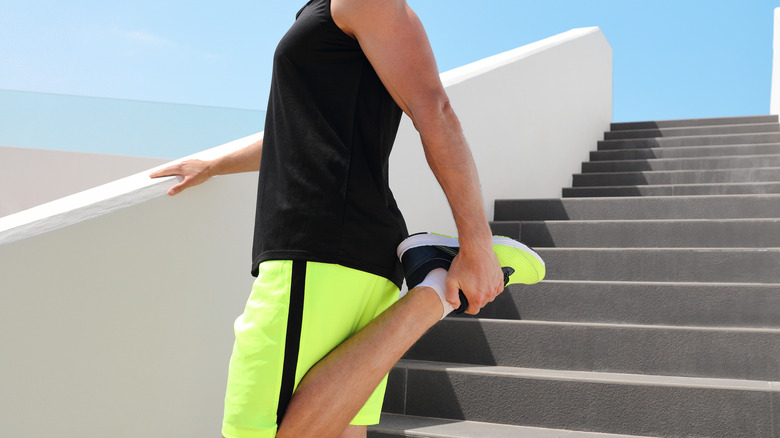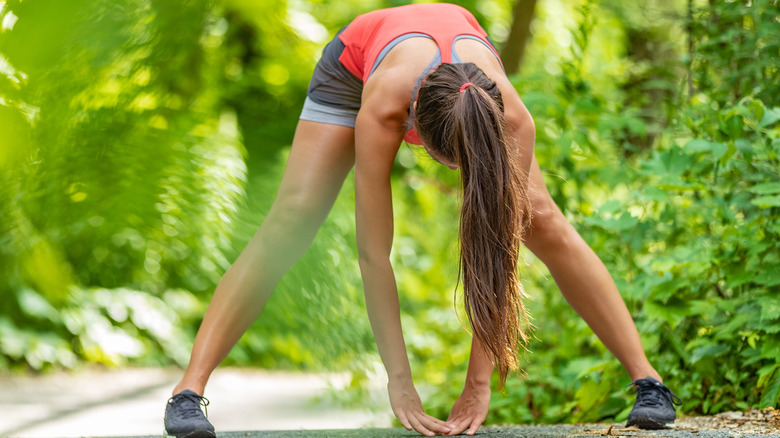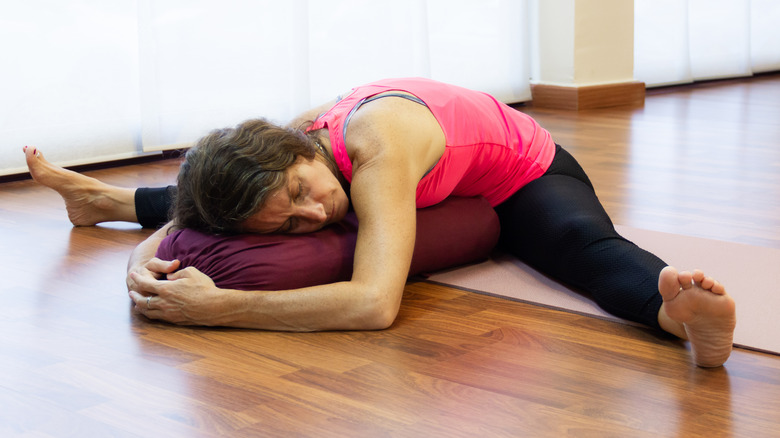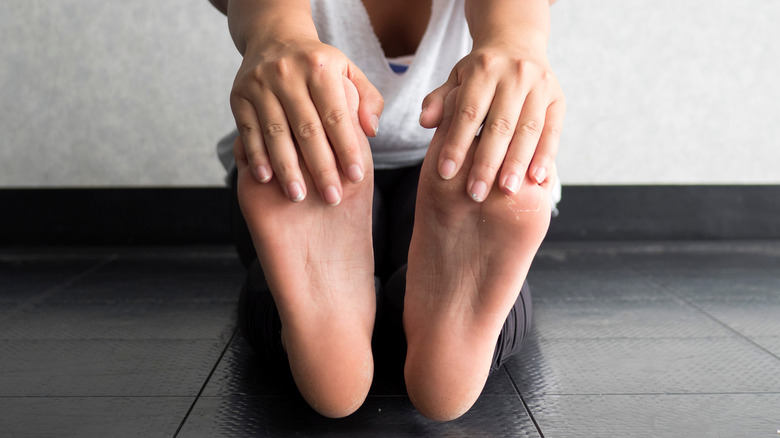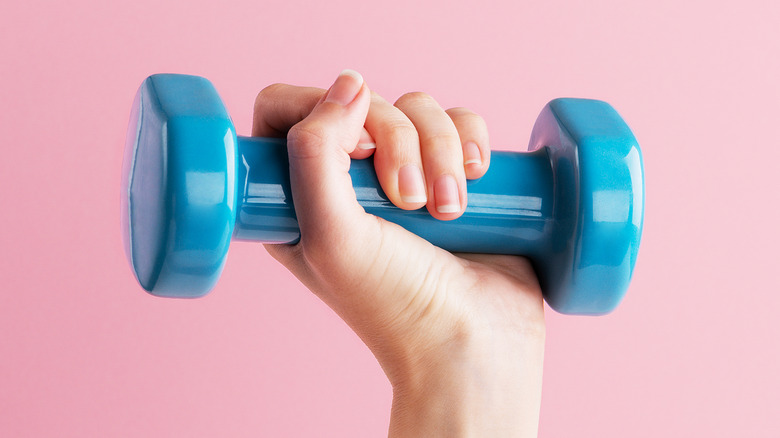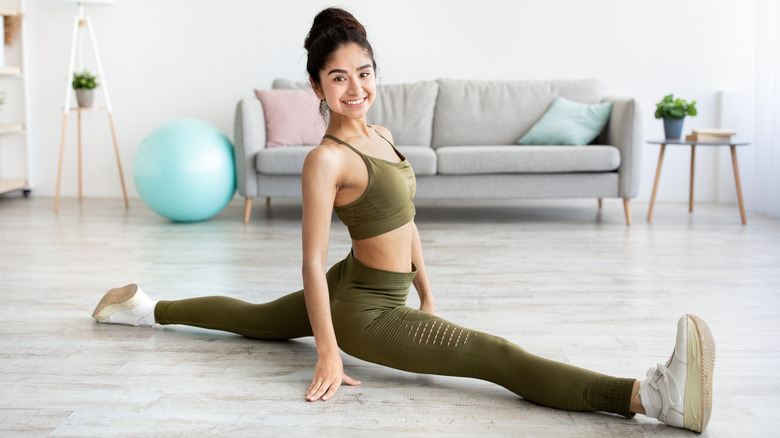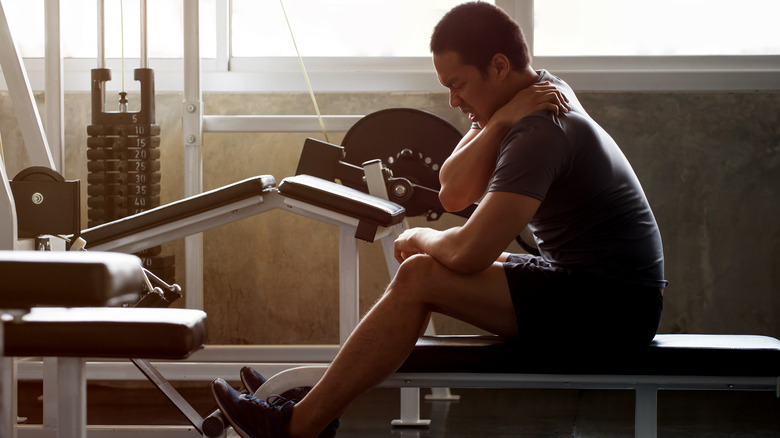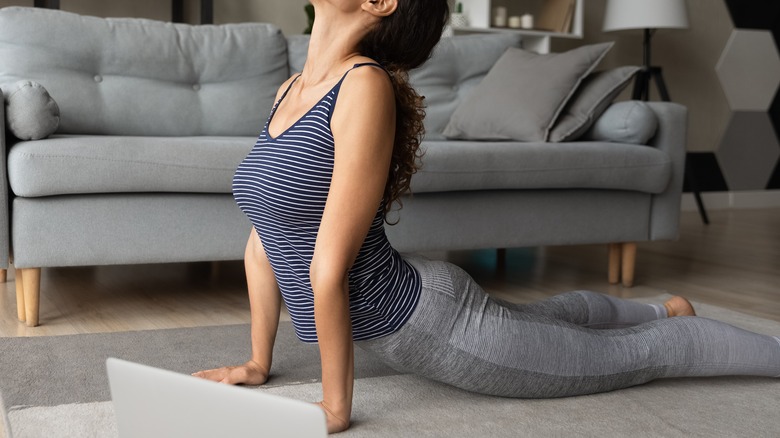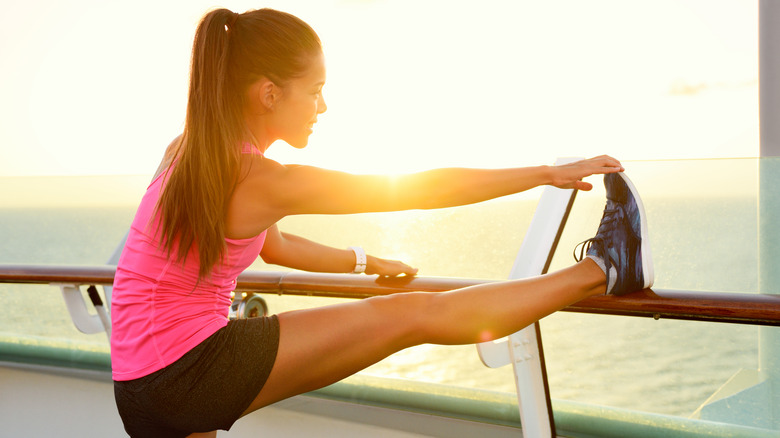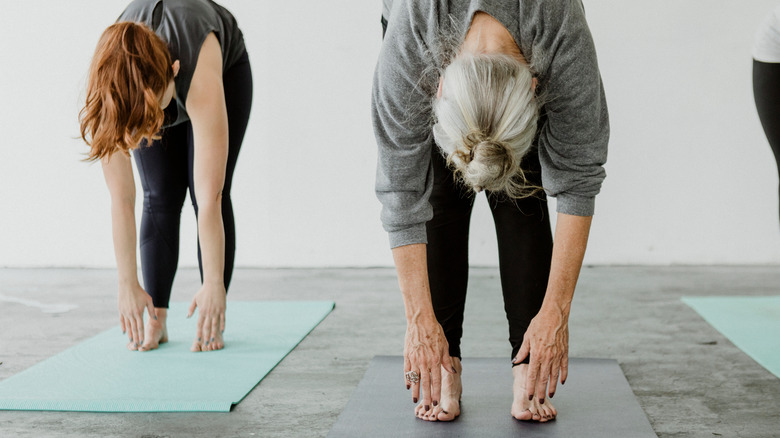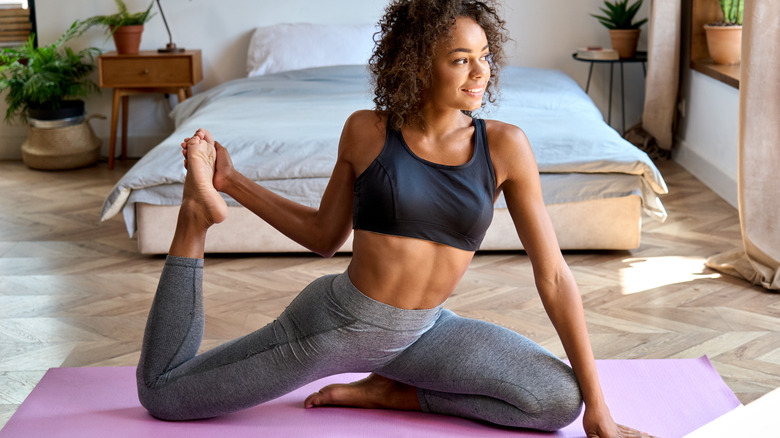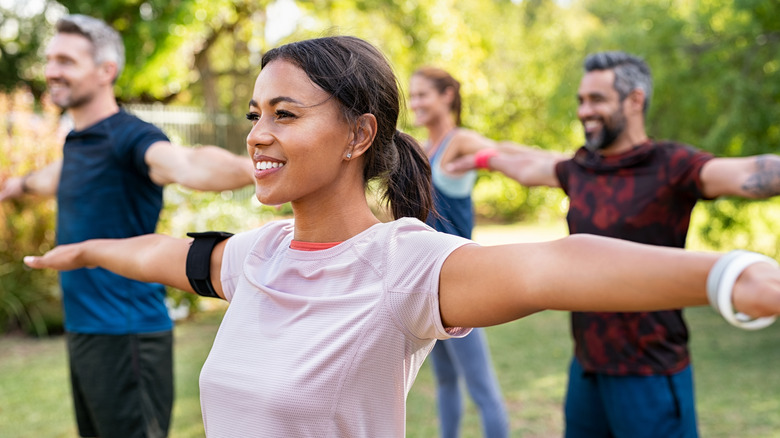Stretches You Should Never Do During Your Workout
Anyone who's ever tried to head out for a jog and immediately experienced a twinge of muscle pain (or felt as though their legs were made of stone) will know how important it is to stretch. And exercise professionals feel the same way, extolling the importance of stretching as a way to condition your muscles before, during, and after working out.
"Stretching should not be overlooked," stresses Massage Envy's lead stretch therapist Kevin Ramsey to NBC News. When you stretch, you're helping to "resolve tension in the muscles. When this tension is resolved, muscles have a better chance of getting the circulation they need to function normally," Ramsey says. In other words, stretching = better performance and full flexibility. We like the sound of that.
But not all stretches are created equal. And while a good stretch can limber up your muscles and facilitate good blood circulation, a bad stretch may have some pretty negative consequences for your body. Crucially, too, there are some stretches out there that are big no-no's to perform — and yet, they're a staple of a lot of people's exercise regimes. Let's take a look at the stretches you really shouldn't be doing.
Hurdler stretch
This stretch, named thanks to its position resembling the graceful sight of a hurdler flying across the track, might seem pretty innocuous at first glance. But performing a hurdler stretch may actually do more harm than good to your body. Due to the positioning of the legs during a hurdler stretch (one extended out in front, the other folded, facing out on an angle), the knee joint of the back leg can have a large amount of stress placed on it, says SportMedBC. This stress can impact the ligaments in the joint pretty profoundly and may lead to strain or injury.
If you've got your heart set on performing hurdler stretches, though (we get it, you wanna relive your high school track days — hurdles were fun), there are some adjustments you can make to improve its safety and efficacy. Try using an elevated surface, like a couch or exercise bench, to stretch your extended leg along. This will allow you to avoid the awkward positioning of the back leg. Making sure you bend your body from your lower back, instead of reaching and hyperextending from the mid-upper back area, will make the stretch more effective overall.
Standing isolated quad stretch
If you've ever been running, or seen someone else running, or seen a film where someone's running, or even thought about running, we're pretty sure this stretch will have featured in the picture. The standing isolated quad stretch, where you stand on one leg, grabbing the other behind you, pulling back slightly to stretch your quadricep, is as at home in a running warmup as an iced latte is on a summer's day. Aside from looking the part, performing a quad stretch will also provide much-needed readying to your quadriceps, which assist your leg in stabilization and providing power when you run (per Healthline). Despite this stretch's near-ubiquity, though, it's actually pretty bad for you, especially when done wrong.
"The standing quadriceps stretch is often performed incorrectly and puts too much stress on the knee joint, causing anterior knee pain," says Professional Physical Therapy's clinic director and certified strength and conditioning specialist Christina Ciccione to Women's Health Magazine. This anterior knee pain may come hand in hand with associated conditioners like runner's knee, and exacerbating the knee joint with an unsafe stretch is, therefore, best avoided.
Any type of ballistic stretching
Let's be real here: Anything with the word "ballistic" in it doesn't exactly inspire feelings of wholesomeness and restoration. And yet, ballistic stretching is still, for some, a mainstay in their exercise routine.
Ballistic stretching is performed by taking regular stretching movements (like touching your toes, for example) and performing them at a higher speed, often bouncing into and out of the stretch to encourage extra range of motion (per Healthline). While that might sound similar to dynamic stretching, ballistic stretching emphasizes speed and extending your movement in a way that dynamic stretching doesn't.
And herein lies the problem, folks. Although ballistic stretching may help to increase flexibility and range of motion in some circumstances, for most people, it's a pretty high-risk way of doing so. Ballistic stretching increases your likelihood of injury or muscular strain, thanks to the jerky, forceful nature of the movements. These can cause harm to your tendons, ligaments, and soft tissue, resulting in tears and pain and essentially making your muscles less flexible. Save yourself the trouble and skip the ballistic stretching. Static or dynamic stretching will encourage movement and flexibility just as well, without the potential to cause problems in the same way.
Straddle stretch
There are few movements out there with as satisfying a name as the "straddle stretch." (Honestly, try saying it out loud — got a serious ring to it, right?). But we can pretty much guarantee that you're not going to be satisfied with what can happen to your body during a straddle stretch.
Though it might feel like a straddling position is the perfect one for a supreme leg stretch, the straddle "is putting both the groin, hip flexors and all inner thigh muscles in position to tighten to protect itself if your body isn't ready," states "Stretch Your Stress Away with ShaNay" author and certified trainer ShaNay Norvell to CNET. Ultimately, this can hinder your flexibility, making this stretch counter-productive.
Instead, to loosen up your groin and inner thighs, go for stretches that'll gently introduce motion to the area. Leg swings are great for these. Stand with your legs hip-width apart, and slowly lift one of your feet, transferring the weight to the standing leg (via Healthline). Take your leg forward and up, then swing it around and back, essentially drawing a semicircle with your knee. Once it's returned to its original position, repeat the movement, increasing in speed and range of motion as your muscles start to limber up.
Sit and reach stretch
Sitting and trying to reach your toes is one of the first stretches people ever learn. So it might shock you to find out (drumroll please) that it's not that good of a stretch, at all.
The first reason for this is the fact that compared to other hamstring stretches, it may not even be that effective. "The sit and reach also often stretches the nerves behind the knee and into the calves more than the hamstring," says National Academy of Sports Medicine faculty instructor Rick Richey to Shape. You can also very easily alter the stretch by rounding your back too much, which reduces the stretch in your hamstrings significantly, making this movement somewhat ineffective.
Instead, opt for a hamstring stretch that you know will work into your legs with maximum impact. A standing hamstring stretch can do just that. Start standing, with your feet regular-width apart, and then cross one leg in front of the other (via Verywell Fit). Bending from your waist, allow your head to roll down so that your forehead is coming towards your front knee. Make sure that your legs don't bend when you do so. Breathe into the stretch, holding it for 15-30 seconds, and then repeat with the other leg.
Posterior deltoid stretch
When we're stretching, it's important to get into our major body parts from a range of different angles, to make sure we're working into all the muscles in each group. The same goes for our delts — but as it turns out, with certain stretches, we may be inviting flexibility where it isn't necessary.
Stretching our posterior deltoids extensively, for example, is pretty pointless. "I have never worked with or even seen someone with tightness or overactivity in this muscle," says NASM faculty instructor Rick Richey via Shape. You can probably skip it, and do a different stretch — one that you'll actually need — instead.
But what about if you're feeling tenderness in that area? Surely, a posterior deltoid stretch might be useful, right? While that may be the case, your twinge may be coming from a different source. Upper back pain may be a result of limited thoracic spine mobility, and if this occurs, the best way to tackle it is with exercises that will specifically address any issues. Practicing a simple cat-cow sequence, and working into your spine as you do so, will introduce flexibility into the area, says Healthline.
Static stretching with weight training
Weight training is a highly popular form of exercise, beloved by bodybuilders and amateur exercisers alike. But combining weight training with a stretching regimen? That's an entirely different ballgame, folks, and not one that we're sure about going to.
Surprisingly, performing static stretching before you do weight training may not be the best idea, due to a few reasons. The first is that when you stretch, you alter the stability in your joints somewhat, according to Runner's World. This change in stability can produce problems when it comes to your weight training and may heighten the risk of injury. You may also usher in the likelihood of injuring yourself when lifting weights following stretching, because of the elongation that occurs in your tendons when you perform static moves. Lengthening your muscles may increase the chance that you'll injure them when picking up a pair of heavy dumbbells.
There is a good time to stretch when you're weight-lifting, though: Afterward. Stretching out your pumped-up muscles after a weights workout can allow them to regain their range of motion and promote flexibility (via Bodybuilding.com).
Split stretch
Ah, the golden days of childhood. Where we could drop into a split with utter effortlessness, leaving the world to marvel at our flexibility. But have you tried doing the splits recently? Not as easy, right? (We wonder where it all went wrong for us...) If, however, you've been overcome with the urge to recapture your split game, we recommend thinking twice before taking the plunge.
"[S]ome people [...] will try to go into a split just to see where their flexibility is. This is still dangerous without warming up thoroughly," warns "Stretch Your Stress Away with ShaNay" author ShaNay Norvell (via CNET). In the worst-case scenario, forcing the splits can cause some troublesome injuries. "An athlete can tear the soft tissues or injure joints, making it difficult to recuperate and continue training," according to University of Utah Health pediatric sports medicine orthopedist Stephen Aoki (per University of Utah Health). Remember that doing the splits, as Aoki explains, is like working up to a marathon. No matter how flexible you used to be, if you haven't done the splits in years, you need to build up endurance slowly and carefully.
Head circles
Our neck is one of the most important parts of our body, and yet we rarely think about how involved it is in movement. But our necks can quickly become active or engaged during exercise, and if they're not cared for properly, this can quickly lead to neck pain or injury (per Harvard Health Publishing).
As such, warming up your neck is essential — but not with head circles. This common stretch is a feature in warm-ups and cool-downs across the board, but when you perform it, you can end up inadvertently causing additional strain to your upper spine, says SportMedBC. This added pressure may squeeze and compress the nerve roots in the spinal area and result in further complications, especially for individuals who experience degenerative disc disease. And the faster and more powerful your head circles are, the more likely your risk of causing injury.
Rather than head circles, you can warm up your neck muscles with simple backward, forward, and side tilts, gently placing your hands on each side of the head while you do so to encourage a little extra stretch, as WebMD explains.
Back-arching stretches
"And round ... And arch ... And round ... Aaaand arch ..." If you're used to the sound of these words being muttered gently from the front of a yoga studio, you'll know the satisfying feeling of working into your spine and back muscles by arching it. But stretches that focus specifically on arching the back can prove seriously problematic for some folks.
Yoga poses like the King Pigeon, Bow, and Cobra, which create an arch in the back, and cause the discs in your spine to compress, as Southeastern Spine Institute discusses. For individuals who have had lower back surgery, this may result in pain or further damage.
And even if you haven't had surgery on your back, it's still a good idea to keep it minimal on the back-arching. The repeated compression on your spinal discs from arching may result in your spine weakening, and may even lead to spondylolysis, an alteration or fracture in one of your discs, causing pain, discomfort, and additional complications (per Livestrong). If you have any doubt about your capacity to perform back-arching exercises, it's best to consult with a doctor or physio before leaping into them.
Elevated hamstring stretch
There are few things more satisfying than giving your hamstrings a good old stretch. But it's important to remember that some hamstring stretches may not be as effective as you think, and the elevated hamstring stretch is one that you can probably retire.
This stretch, which involves placing an extended leg out in front of you on an elevated surface and leaning over it, may feel good. However, your hamstring isn't really getting much action with this move. "In reality, this sensation is only tension being applied to the sciatic nerve," says Professional Physical Therapy physical therapist Christina Ciccione to Women's Health Magazine. "The hamstring isn't actually increasing in length or becoming more flexible."
Rather than an elevated hamstring stretch, try taking things to the floor with a lying hamstring stretch. Lie on your back with your feet flat on the ground, and gradually lift one of your legs above your body, extending it as you do so, placing your hands on the back of your thigh (per Medical News Today). Gently pull the leg in towards your chest, holding the pose for 15-30 seconds, before lowering it back to the ground and repeating with the other leg.
Static forward folds
The static forward fold is a classic hamstring stretch, with most of us at some point in our lives doing it to try and touch our toes. But — and we're sorry to be the people to rewrite everything we ever knew — in truth, a static forward fold is not that good for our hamstrings, and may even make our workouts worse.
"The hamstrings are a huge muscle group assisting in squats, deadlifting, running, and lunging," says certified strength and conditioning specialist Christina Ciccione to Women's Health Magazine. Stretching them out using a static position may actually be pretty detrimental to loosening up these massive muscles, and can "potentially lead to painful injuries like microtears, which could limit your movement," Ciccione stresses.
As such, stretching out your hamstrings (as well as the rest of your legs) using gently dynamic movements may be your best option for optimal performance. Enter the downward dog, the classic yoga pose, performed by pushing your body up so that it's in a steeple position, with your hands and your feet pushing into the floor (per Women's Health Magazine). The downward dog will provide an ample stretch through your hamstrings, which can be heightened if you pedal your feet out gently in the position.
Pigeon pose
The pigeon pose is not for the faint of heart, folks. And while this heroic yoga pose is beloved by millions of people around the world, unless you're confident in performing it and are willing to take it slow, it might be best to remove it from your repertoire entirely.
The pigeon pose can work well as a hip opener and can be beneficial to your lower back, but due to the position of the movement, injury can potentially occur if you overexert yourself (via Healthline). More specifically, the pigeon pose may incur further issues in people who experience pain or discomfort in their lower backs, hips, or knees.
It may also be the case that the pigeon pose delivers too extreme of a stretch to your gluteal tendons, which may make them weaker. If you're still determined to master the pigeon, though, we'd advise making some adjustments to make it a little safer, especially if you're new to the exercise. Try tucking a rolled-up towel or cushion underneath your folded leg and glute, to increase the support while you stretch and stop you from feeling excess pressure. This will prevent the stretch from becoming too strong.
So what's the best way to stretch?
As much as there is a wrong way to stretch, there's a right way to stretch, too. And don't be fooled by the assumption that stretching is a no-risk activity: Stretching out tight muscles can cause injury if done incorrectly, as Harvard Health Publishing states, no matter what type of stretch you're doing.
That's why it's important to follow a few simple pointers to nail your stretch game. Try not to go into stretching completely cold, and if you can, warm up your muscles a little first by performing some gentle movements. Keep focused on which muscle you're trying to stretch out, and ensure that your form and posture are correct, to get the most out of your stretch and avoid strain. Keep your breathing steady and deep as you stretch, and avoid holding your breath (which can happen without you even realizing it).
Most importantly, if you feel pain, stop! You should feel a little tension when you stretch, but pain should not be on the agenda, people. If your stretch hurts, pause and reassess. You could be pushing yourself too far, or there might be a problem with your form.


